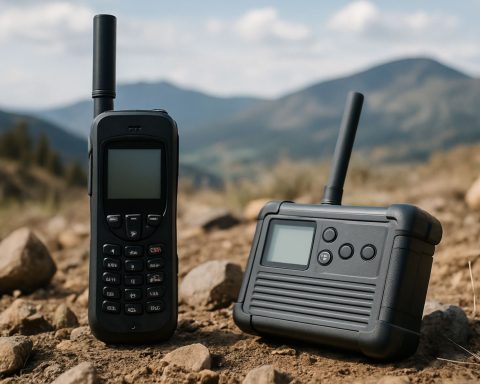Your Complete Guide to Satellite Phones: Leading Models, Market Insights, and Off-Grid Connectivity Solutions
- Market Overview: Satellite Phone Adoption and Demand Drivers
- Emerging Technology Trends in Satellite Communication Devices
- Competitive Landscape: Key Players and Product Comparisons
- Growth Forecasts: Market Expansion and Revenue Projections
- Regional Analysis: Global Hotspots and Adoption Patterns
- Future Outlook: Innovations and Evolving User Needs
- Challenges and Opportunities in the Satellite Phone Market
- Sources & References
“Satellite phones remain essential for reliable off-grid communication, even as mainstream smartphones gain limited satellite texting features.” (source)
Market Overview: Satellite Phone Adoption and Demand Drivers
The global satellite phone market is experiencing robust growth, driven by increasing demand for reliable off-grid communication in remote areas, disaster response, maritime operations, and adventure travel. As terrestrial cellular networks remain limited in coverage—reaching only about 15% of the Earth’s surface—satellite phones have become indispensable for users requiring connectivity beyond traditional infrastructure (GSMA).
According to recent market research, the satellite phone market is projected to reach $6.5 billion by 2025, growing at a CAGR of 4.5% from 2020 to 2025 (MarketsandMarkets). This growth is fueled by several key demand drivers:
- Disaster Preparedness and Emergency Response: Governments and NGOs increasingly rely on satellite phones for resilient communication during natural disasters, when terrestrial networks are often compromised. The 2023 Maui wildfires and Turkey-Syria earthquakes highlighted the critical role of satellite connectivity in crisis management (Reuters).
- Remote Work and Exploration: The rise in remote scientific expeditions, mining, oil & gas operations, and eco-tourism has expanded the user base for satellite phones, especially in regions like the Arctic, Amazon, and open oceans.
- Maritime and Aviation Safety: International maritime regulations and aviation authorities mandate satellite communication for safety and tracking, further boosting adoption among commercial fleets and private vessels (IMO).
- Technological Advancements: The introduction of compact, lightweight models with improved battery life, global coverage, and integration with smartphones (e.g., Iridium GO! exec, Thuraya X5-Touch) has made satellite phones more accessible and user-friendly (Iridium).
- Consumer Awareness: High-profile launches, such as Apple’s Emergency SOS via satellite and Starlink’s direct-to-device initiatives, have raised public awareness and expectations for ubiquitous connectivity (Apple).
In summary, the satellite phone market in 2025 is shaped by a convergence of safety imperatives, technological innovation, and expanding use cases. As competition intensifies among providers like Iridium, Inmarsat, Thuraya, and Globalstar, consumers can expect a broader selection of models tailored for diverse off-grid communication needs.
Emerging Technology Trends in Satellite Communication Devices
As satellite communication technology rapidly evolves, 2025 is shaping up to be a pivotal year for satellite phones, especially for users seeking reliable off-grid connectivity. The latest models are leveraging advancements in miniaturization, battery efficiency, and network integration, making them more accessible and powerful than ever before. Here’s a comprehensive comparison of the top satellite phones expected to dominate the market in 2025, focusing on their features, network coverage, and suitability for various off-grid scenarios.
- Iridium Extreme 9575: Renowned for its global coverage via the Iridium satellite network, the 9575 offers robust voice and data capabilities, military-grade durability, and an SOS button linked to emergency response services. Its battery life supports up to 30 hours of standby and 4 hours of talk time, making it ideal for expeditions and remote workers.
- Inmarsat IsatPhone 2: Utilizing the Inmarsat network, this model provides reliable coverage outside polar regions. It boasts a long battery life (up to 160 hours standby), weather resistance, and GPS tracking. Its user-friendly interface and affordable airtime plans make it a favorite among humanitarian organizations and adventure travelers.
- Thuraya X5-Touch: As the world’s first Android-based satellite phone, the X5-Touch combines smartphone functionality with satellite connectivity via the Thuraya network. It features a 5.2-inch touchscreen, dual SIM capability (satellite and GSM), and advanced navigation tools, catering to tech-savvy users in Europe, Africa, Asia, and Australia.
- Globalstar GSP-1700: Known for its compact design and affordable service plans, the GSP-1700 operates on the Globalstar network. While its coverage is limited compared to Iridium and Inmarsat, it’s a cost-effective choice for users in North America and parts of South America.
Emerging trends for 2025 include the integration of satellite messaging into mainstream smartphones, as seen with Apple’s Emergency SOS via satellite and the expansion of low-Earth orbit (LEO) constellations like Starlink and Lynk, promising faster data speeds and broader coverage. As these technologies mature, users can expect more affordable, compact, and versatile satellite communication devices, further bridging the digital divide for off-grid adventurers and professionals alike.
Competitive Landscape: Key Players and Product Comparisons
The satellite phone market is evolving rapidly as demand for reliable off-grid communication grows among adventurers, emergency responders, and remote workers. In 2025, the competitive landscape is shaped by established players like Iridium, Inmarsat, and Globalstar, as well as emerging contenders such as Thuraya and new entrants leveraging low-Earth orbit (LEO) constellations. Below, we compare the best satellite phone models, focusing on coverage, features, and value.
- Iridium 9575 Extreme: Iridium remains the gold standard for global coverage, thanks to its 66-satellite LEO constellation. The 9575 Extreme offers military-grade durability, GPS tracking, SOS functionality, and voice/data services. Its global reach is unmatched, making it ideal for polar expeditions and maritime use. However, its price point (around $1,200) and higher airtime costs are notable considerations (Iridium).
- Inmarsat IsatPhone 2: Inmarsat’s IsatPhone 2 is praised for its robust battery life (up to 8 hours talk time, 160 hours standby) and reliable voice clarity. While its geostationary satellites provide strong coverage across most of the globe, polar regions are excluded. The device is competitively priced (around $700) and offers affordable airtime plans, making it a favorite for budget-conscious users (Inmarsat).
- Globalstar GSP-1700: Globalstar’s GSP-1700 is compact and lightweight, with fast data speeds for email and basic web access. Its coverage is strongest in North America, Europe, and parts of Asia, but less reliable in Africa and polar regions. The device is attractively priced (around $500), but users should verify coverage maps before purchase (Globalstar).
- Thuraya X5-Touch: Thuraya’s X5-Touch is the world’s first Android-based satellite phone, blending smartphone functionality with satellite connectivity. It offers dual SIM capability (satellite and GSM), a 5.2-inch touchscreen, and access to Google Play apps. Coverage is focused on Europe, Africa, Asia, and Australia, with limited service in the Americas. Pricing is around $1,100 (Thuraya).
- Starlink Direct-to-Device (D2D) Beta: In 2025, Starlink is piloting its D2D service, enabling select smartphones to connect directly to its LEO satellites for text and limited voice. While not a traditional satellite phone, this innovation could disrupt the market by offering affordable, global connectivity (Starlink).
In summary, Iridium leads for global reach and ruggedness, Inmarsat excels in value and battery life, Globalstar is best for North American users, Thuraya offers smartphone versatility, and Starlink’s D2D service signals a potential paradigm shift. Buyers should weigh coverage, device features, and cost to select the best satellite phone for their off-grid needs in 2025.
Growth Forecasts: Market Expansion and Revenue Projections
The satellite phone market is poised for significant growth as demand for reliable off-grid communication surges across sectors such as emergency response, adventure tourism, maritime, and remote industrial operations. According to a recent report by MarketsandMarkets, the global satellite phone market is projected to reach $6.1 billion by 2025, up from $4.8 billion in 2020, reflecting a compound annual growth rate (CAGR) of 4.9%.
This expansion is driven by several factors:
- Increasing Natural Disasters: The frequency of natural disasters has heightened the need for resilient communication infrastructure, especially in areas where terrestrial networks are vulnerable or nonexistent.
- Remote Work and Exploration: The rise in remote work, scientific expeditions, and adventure travel has fueled demand for portable, reliable satellite phones.
- Technological Advancements: Newer models offer improved battery life, global coverage, and integration with data services, making them more attractive to a broader user base.
Regionally, North America remains the largest market, driven by government, military, and disaster management applications. However, Asia-Pacific is expected to witness the fastest growth due to expanding infrastructure projects and increased awareness of emergency preparedness.
In terms of product innovation, leading manufacturers such as Iridium, Inmarsat, and Thuraya are introducing models with enhanced durability, user-friendly interfaces, and hybrid connectivity options. For example, the Iridium 9575 Extreme and Inmarsat IsatPhone 2 are frequently cited as top choices for 2025, offering robust performance in harsh environments.
Revenue projections are further buoyed by the integration of satellite phones with IoT devices and the rollout of next-generation satellite constellations, which promise lower latency and higher data speeds. As a result, the satellite phone market is set to remain a critical component of global communication infrastructure, with robust growth anticipated through 2025 and beyond.
Regional Analysis: Global Hotspots and Adoption Patterns
The global satellite phone market is experiencing dynamic growth, with adoption patterns and regional hotspots shaped by geography, infrastructure, and security needs. As we approach 2025, satellite phones are increasingly vital for off-grid communication, disaster response, and remote operations. The market is projected to reach USD 6.0 billion by 2027, growing at a CAGR of 4.5% from 2022, driven by demand in regions with limited terrestrial connectivity.
- North America: The United States and Canada remain the largest markets, fueled by government, military, and emergency services. The U.S. Federal Emergency Management Agency (FEMA) and similar organizations rely on satellite phones for disaster preparedness. The Arctic and remote wilderness areas in Canada also drive adoption among resource extraction industries and adventure travelers (Grand View Research).
- Asia-Pacific: Rapid growth is seen in Southeast Asia, Australia, and the Pacific Islands, where natural disasters and vast rural expanses necessitate reliable off-grid communication. Australia’s mining sector and Indonesia’s archipelagic geography are key drivers. China and India are investing in satellite infrastructure to support both civilian and defense needs (GlobeNewswire).
- Europe: Adoption is steady, with hotspots in Scandinavia, the Alps, and Eastern Europe. Emergency services, maritime industries, and adventure tourism are primary users. The European Space Agency’s initiatives to improve satellite coverage are expected to further boost usage (Euroconsult).
- Middle East & Africa: High demand stems from oil & gas, humanitarian operations, and remote infrastructure projects. In Africa, satellite phones are crucial for NGOs and governments operating in areas with unreliable cellular networks. The Middle East’s desert regions and offshore industries also contribute to market growth (Research and Markets).
- Latin America: Adoption is rising in the Amazon basin, Andes, and remote agricultural zones. Disaster response and environmental monitoring agencies are key users, especially in Brazil, Chile, and Argentina (Market Research Future).
In summary, the 2025 satellite phone landscape is defined by regional needs: disaster resilience in Asia-Pacific, resource extraction in North America and Australia, and humanitarian operations in Africa. These patterns shape the demand for robust, reliable satellite phone models tailored to each region’s unique challenges.
Future Outlook: Innovations and Evolving User Needs
The satellite phone market is poised for significant transformation in 2025, driven by rapid technological innovation and evolving user demands for reliable off-grid communication. As global connectivity becomes increasingly vital for adventurers, emergency responders, and remote workers, manufacturers are responding with advanced features, improved coverage, and more affordable options.
Technological Innovations
- 5G Integration: Leading satellite phone providers are exploring 5G compatibility, promising faster data speeds and lower latency. This will enable richer communication experiences, including video calls and real-time data sharing, even in the most remote locations (GSMA).
- Miniaturization and Durability: New models are becoming lighter and more rugged, with IP68 ratings for water and dust resistance, and MIL-STD-810G certification for shock and temperature extremes (Satellite Today).
- Enhanced Battery Life: Innovations in battery technology are extending standby and talk times, with some 2025 models expected to last up to 72 hours on a single charge, addressing a key pain point for off-grid users.
- Global Roaming and Multi-Network Support: Devices are increasingly supporting seamless switching between satellite constellations (Iridium, Globalstar, Inmarsat, and Starlink), ensuring uninterrupted coverage worldwide (Space.com).
Evolving User Needs
- Affordability: As demand grows, competition is driving down device and airtime costs. Entry-level models are expected to retail below $500, making satellite phones accessible to a broader audience (Statista).
- Ease of Use: User interfaces are becoming more intuitive, with smartphone-like touchscreens, voice assistants, and simplified emergency SOS features.
- Data-Driven Applications: Users increasingly expect satellite phones to support messaging apps, GPS navigation, and weather updates, blurring the line between traditional satellite phones and smart devices.
Looking ahead, the 2025 satellite phone landscape will be defined by smarter, more resilient devices that cater to both professional and recreational users. As satellite networks expand and technology advances, off-grid communication will become more seamless, secure, and accessible than ever before.
Challenges and Opportunities in the Satellite Phone Market
The satellite phone market is undergoing significant transformation as demand for reliable off-grid communication surges. In 2025, the landscape is shaped by both persistent challenges and emerging opportunities, influencing the selection and performance of the best satellite phone models.
- Coverage and Connectivity: One of the main challenges remains global coverage. While leading providers like Iridium and Inmarsat offer near-global reach, coverage gaps persist in polar regions and deep canyons. New entrants such as Starlink are exploring direct-to-device satellite connectivity, which could revolutionize accessibility by 2025 (CNBC).
- Device Cost and Affordability: Satellite phones remain more expensive than conventional smartphones, with flagship models like the Iridium 9575 Extreme retailing above $1,000. However, increased competition and technological advancements are expected to drive prices down, making off-grid communication more accessible (MarketsandMarkets).
- Regulatory Barriers: Import restrictions and licensing requirements in countries such as India and China continue to limit market expansion. Manufacturers are working with regulators to streamline approval processes, but progress is gradual (GSMA).
- Technological Innovation: The integration of satellite messaging into mainstream smartphones, as seen with Apple’s Emergency SOS via satellite, is blurring the lines between dedicated satellite phones and consumer devices (Apple). This trend presents opportunities for hybrid devices and expanded user bases.
- Market Growth: The global satellite phone market is projected to grow at a CAGR of 4.5% through 2028, driven by increased demand from adventure travelers, maritime operators, and emergency responders (GlobeNewswire).
In summary, the 2025 satellite phone market is defined by a dynamic interplay of challenges and opportunities. As technology evolves and new players enter the field, consumers can expect more affordable, versatile, and reliable options for off-grid communication.
Sources & References
- The Ultimate 2025 Satellite Phone Guide – Best Models Compared for Off-Grid Communication
- MarketsandMarkets
- IMO
- Iridium 9575 Extreme
- Apple
- Thuraya
- Starlink
- Lynk
- GlobeNewswire
- Grand View Research
- Euroconsult
- Research and Markets
- Market Research Future
- Satellite Today
- Space.com
- Statista
- CNBC








